The eLearning industry is projected to grow to $1 trillion by 2028. A major player in the industry is Udemy with over 50 million learners on its books and an extensive library of over 200,000 courses.
But while Udemy is a popular choice for online learning, it’s not the only option on the market. In fact, there are a wide range of Udemy alternatives that offer both creators and learners more control, more creative freedom, and more cost effective solutions – so you can keep more of what you earn on the platform.
Here’s our pick of the top Udemy alternatives in 2023 including top features, pros, cons, and more.
Follow along or skip ahead:
- Best Udemy alternatives comparison table
- Quick intro to Udemy
- Top 6 best Udemy alternatives
- Best Udemy Alternative for Creator Educators: Thinkific
- Best Udemy alternative for free marketing: Skillshare
- Best Udemy alternative for Tech specialists: Udacity
- Best Udemy alternative for accredited courses: Coursera
- Best Udemy alternative for students: Khan Academy
- Best Udemy alternative for Data Science: DataCamp
- How to choose the best Udemy alternative for you
Free Buyer’s Guide: The Best Online Course Platforms
Get a run-down of the 9 of the best Online Course Platforms, 6 must-know features, and what their customers say about them with this guide.
Best Udemy alternatives comparison table
| Udemy Alternatives | Course Types | Best for… | Pros | Cons |
| Thinkific | Online learning platform | Creator Educators who want full ownership over their online education content |
|
|
| Skillshare | Subscription-based marketplace | Course creators who want help promoting their courses |
|
|
| Udacity | Course marketplace | Industry leaders with time to teach |
|
|
| Coursera | Course marketplace | Institutions like universities and large corporations |
|
|
| Khan Academy | Non-profit marketplace | High school students and public educators |
|
|
| DataCamp | Subscription-based marketplace | Data scientists with serious analytics chops |
|
|
Quick intro to Udemy
Founded by Eren Bali, Gagan Biyani, and Oktay Caglar in 2010, Udemy has grown to attract more than 52 million students, as well as 68,000 instructors who create courses on everything from synthesizers to Adobe Photoshop. Throughout the early stages of the pandemic, Udemy saw a 425% increase in paid enrollments as more people switched to online learning.
Udemy is a well-known platform that offers some solid benefits to Creator Educators, including its beginner-friendly setup that lets you produce and promote online courses with no technical or design expertise. As a course marketplace, Udemy offers creators a large audience base to market your products to – but it’s not without its disadvantages.
While it’s easy to get started with Udemy, it can be challenging for creators and educators to earn an income from the platform as you have zero control over course pricing. Udemy also takes the lion’s share of any profits you make, pocketing 63% of the revenue from any courses sold through the Udemy Marketplace. Then there’s the problem of ownership – you have no ownership over the data on the platform, including your customers’ and learners’ data, so you have very limited control over your business.
Udemy pros
- Easy to start: It’s simple to sign-up to Udemy and the platform provides resources to help you with planning, recording and publishing your first course.
- Extensive course library: Udemy is well-known for its course library featuring over 200,000 courses across a wide range of topics.
- Global instructor community: Join a community of thousands of instructors across the world to get tips and guidance on becoming a successful course creator.
Udemy cons
- Competitive marketplace: The huge number of courses on Udemy’s course marketplace means it’s tough to get your content seen – and even tougher to stand out from the crowd.
- No ownership of data: Instructors don’t have ownership over their customers’ data so your business is dependent on Udemy. That means it’s harder to grow your business, switch platforms, and retain control.
- Extensive requirements to follow: Udemy runs quality control on all courses uploaded to the marketplace with an extensive list of requirements you need to follow to get your content approved. That’s a lot of hoops to jump through.
- High fees: Udemy takes a cut of everything you make on the platform – if you sell your course through the Udemy Marketplace, they take 63% of anything you earn.
Udemy is a popular online learning platform – but it’s not the only option available. Ready to explore the best Udemy alternatives in 2024? Here’s our pick of the top solutions you need to know about.
Top 6 best Udemy alternatives
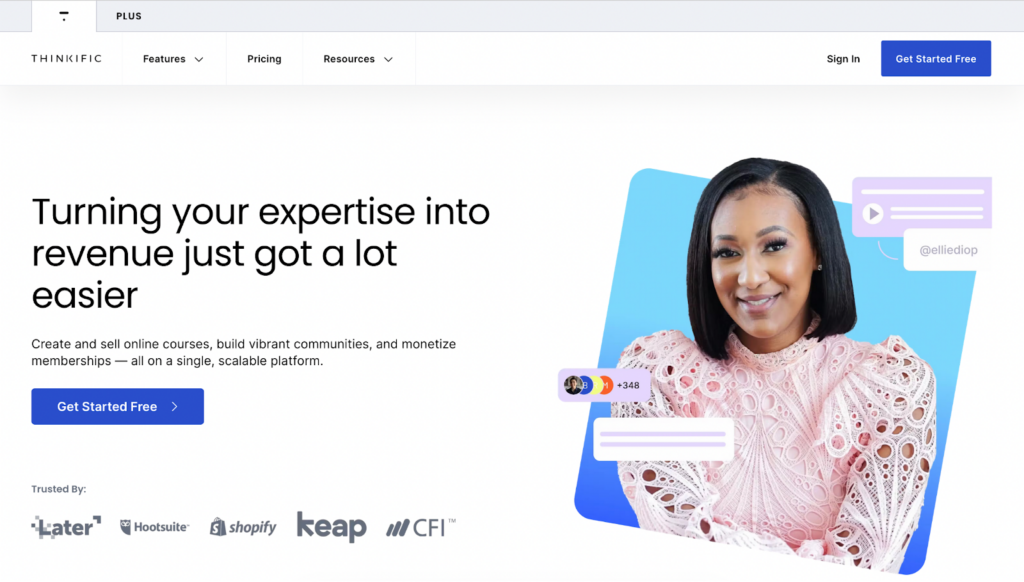
Looking to build, host, promote, and earn money from your online courses? Thinkific could be the Udemy alternative for you. The Vancouver-founded online learning platform gives creators everything you need to sell courses and digital products through your own customized branded site.
Create, manage and market your learning content with features like custom site themes and domains, dedicated community spaces, and a dedicated mobile app. Use the Thinkific Site Builder to design an eye-catching website to show off your online courses and digital products with customizable fonts and colors to match your brand. Use detailed analytics to learn more about your customers – and tailor your content to your target audience to maximize your impact.
When it comes to designing your online courses, Thinkific’s Course Creator has everything you need to get started. Choose from a range of professionally-made templates to help you organize and structure your content. Create mini-courses, landing pages, membership sites, and more. And when you’re ready to start marketing your products, take advantage of Thinkific’s suite of built-in marketing tools – like bundles, coupons, and cross-selling features.
Thinkific’s plans start at $0/month including everything you need to create your first digital product, including access to easy-to-use website templates and the drag-and-drop Course Builder.
As you create more courses and grow your business, you have the chance to upgrade to a Start plan for $99/month. The paid plan grants you access to a wider range of features, including customizable completion certificates, unlimited courses, private and hidden courses, and much more.
Plus, if you’re looking to scale fast, Thinkific is built to grow with you. The best part? You retain 100% ownership over your content – and all the profits from your sales. Whether you’re just starting out or you’re further along your creator journey, that’s a major win.
See how creator Ellie Diop made 7 figures in less than a year with Thinkific.
Pros:
- Keep more of your profits: Unlike Udemy, what you sell is what you earn on this platform. Thinkific won’t take a cut from any of your sales so all your profits go in your pocket.
- Completely customizable: Thinkific offers a wide range of customization features to help you create your own branded site and learning experience. And you also get access to a library of 3rd-party integrations to get more of the tools you need.
- Custom domains: Thinkific’s paid plans let you create a custom website and add your own domain – so it looks like you built it all yourself.
- Feature-packed free plan: Thinkific’s free tier includes a generous amount of features for new creators, including a library of pre-built website templates and drag-and-drop course creation tools.
- Flat monthly fee: Thinkific uses a transparent pricing system with a flat monthly fee so you keep more from each sale.
- Earn recurring revenue: Choose from a range of pricing structures to sell your products – including memberships and subscriptions to generate monthly recurring revenue for your business.
Cons:
- No course marketplace: Thinkific makes it easy to publish and sell your courses through your own branded website – rather than a course marketplace.
- Limited features on free plan: To access the full range of features on the Thinkific platform, you’ll need to upgrade to a paid subscription.
- Few email marketing features: If you want to market your products using email marketing, you’ll need to use a dedicated platform alongside Thinkific.
Related: Udemy vs Thinkific
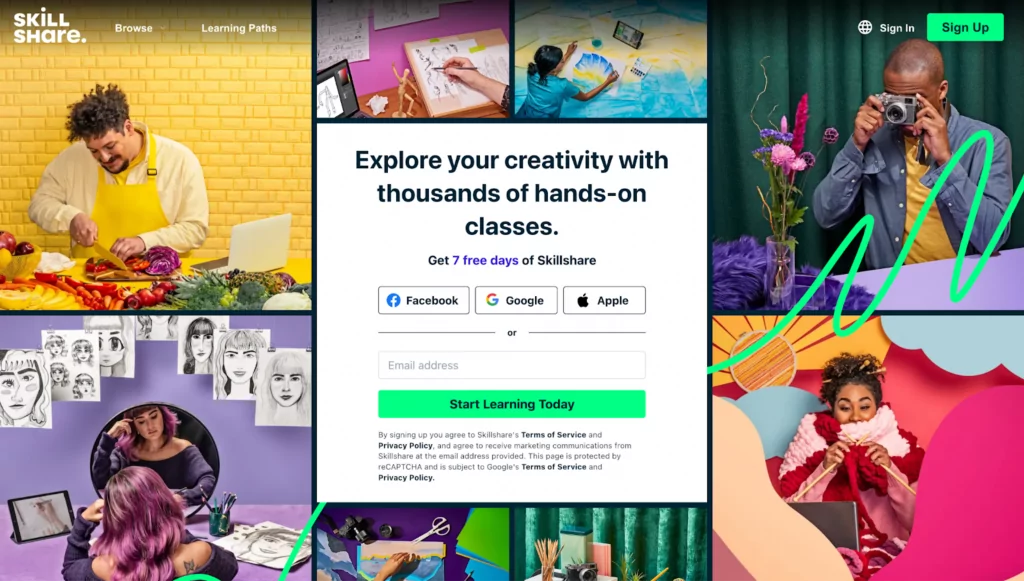
Skillshare is one of the best-known Udemy alternatives and one of the largest online learning marketplaces. The platform was founded in 2010 and now boasts over 12 million members.
Like Udemy, you’ll sign up as a course creator, develop your course content and then publish it online. But where Skillshare is different is in the marketing of your course. The Skillshare marketplace takes care of all promotion of your content and connects learners with industry experts, so most of the marketing work is done for you.
Another key difference between Skillshare and Udemy is that Skillshare uses a subscription model for pricing and purchasing courses. While Udemy students pay for individual courses, Skillshare students pay a flat fee to access all the courses on the platform.
This means instructors like you get paid out of Skillshare’s royalty pool, rather than from individual course sales. 30% of all monthly Premium Membership fees go into the royalty pool and creators are allocated a chunk based on the amount of ‘watch time’ your content racks up in a given month.
You can also get paid for referring new students. Skillshare instructors get paid a $10 bonus for each new student who signs up with a referral link, which means you can monetize any existing audience you’ve built outside Skillshare.
Pros:
- Large potential audience: Skillshare has a built-in audience of millions, so the potential viewership for your content is huge.
- High quality course content: Because Skillshare pays creators based on time spent watching your content, there’s extra incentive to create higher quality courses that will be watched for longer by more people.
- Arts-oriented learners: While many eLearning platforms like Udemy focus heavily on business and technology topics, Skillshare’s learners tend to be more passionate about art and craft-related skills – so if that’s your niche that’s a big plus.
Cons:
- Limited earning potential: Creators get paid from the ‘instructor pool’ based on how much time learners spend watching your content, not based on how many sales you make or your course pricing.
- No guaranteed income: If your course isn’t watched enough, you might not meet your revenue goals – which means no income that month.
- Monthly payments for royalties: Royalty payments occur monthly rather than bi-weekly so you’ll have to wait to see any earnings in your bank account.
Related: Thinkific vs Skillshare
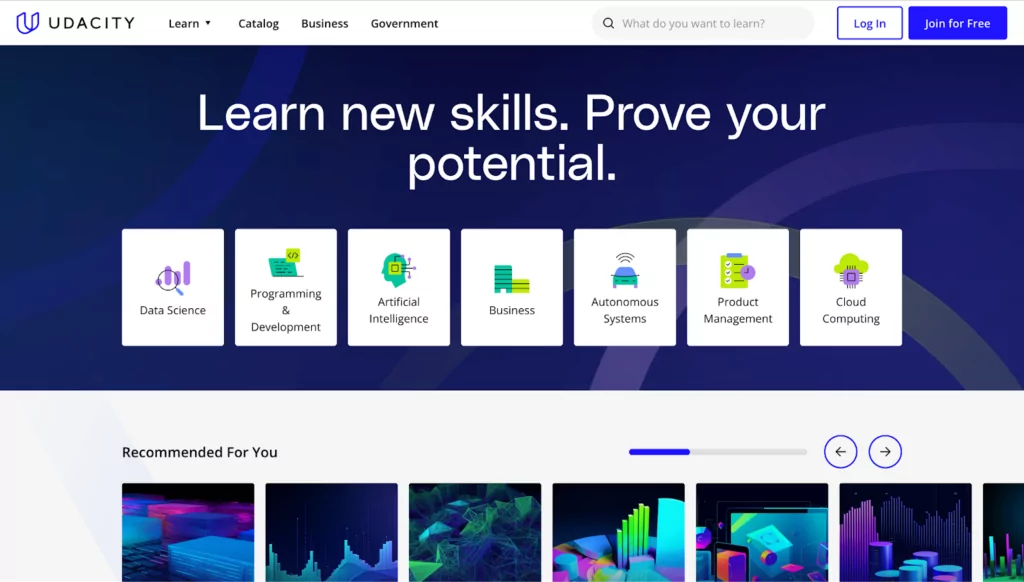
Udacity is an online course platform geared towards the tech industry. Unlike Udemy, Udacity offers guided learning programs called Nanodegrees which are project and skills-based development programs that eventually lead to educational credits. They’re longer and more guided than your average Udemy course and include assignments and project reviews with dedicated instructors and teachers.
Creators develop courses alongside the Udacity team who provide guidance and feedback on learning content. Educators are also responsible for creating lessons, videos, projects, quizzes, and test materials for students, as well as developing promotional materials to help market their new courses.
Most Udacity instructors aren’t working alone – they’re usually part of an established institution. Udacity’s Machine Learning Engineering curriculum was developed directly by Google’s Deep Learning team, for example. In general, Udacity instructors come from Fortune 500 and Global 2000 companies and are already well-established in their fields. That means Udacity credentials are valuable for demonstrating your skills and expertise in your field because Udacity only works with subject matter experts – but it also means it can be a tough market to break into.
As a course creator, getting started on Udacity isn’t as easy as simply creating your content like on other learning platforms. Instead, you’ll need to apply via Udacity’s Instructor Opportunity Portal and you’ll need to prove you’ve got 5+ years of expertise in your field, as well as being willing to commit approximately 15-20 hours per week to work with learners. Your earnings are also determined according to your seniority in your field, so there’s a limit to how much you can make on the platform when you’re first starting out.
Pros:
- Boost your credibility: Unlike Udemy, Udacity is an exclusive platform that’s dedicated to subject-matter experts and market leaders – so your presence on the platform can be a boost for your brand reputation.
- Guaranteed income stream: Instructors who are selected as Udacity partners sign contracts and get regular pay from the platform.
- Dedicated marketing help: Udacity partners with instructors to create a course promo – and your course will be promoted on the Udacity homepage.
Cons:
- Significant time commitment: Udacity instructors are expected to help promote and maintain their courses, so you’re not earning a passive income. Most instructors work between 15-20 hours per week on the platform.
- High barrier to entry: Udacity is only open to industry experts and institutional partners, so it’s not suited to newer creators.
- Smaller audience base: Udacity courses are far more expensive than courses sold through other platforms. As a result, Udacity’s user base is smaller—but they’re a very dedicated bunch.
Boasting over 5,300 courses, as well as a range of progressional courses, specializations and Mastertrack courses, Coursera is a prestigious Udemy alternative that’s geared towards business pros and academics.The main draw of Coursera’s certifications is that they come from accredited institutions – the type your mom would recognize. Students earn certifications that they can use to transfer into colleges and earn course credits, all from the comfort of their own home. Learners from less traditional academic backgrounds can also open up serious doors with Coursera certifications too. Unlike Udemy, every Coursera course is designed to last between four and twelve weeks with approximately one to two video lectures per week. Instructors grade assignments, answer student questions and help provide an engaging learning experience.Coursera has over 275 partnerships with universities and institutions around the world – including the University of London, Yale University, the University of California, Irvine, and the University of Michigan, as well as Meta and Google.
Working with large institutions does slow down the application process though. While it’s faster than applying for a university degree, many learners prefer to learn on alternative online platforms where signing up and starting a course takes a matter of minutes rather than days.
Pros:
- Wide range of free courses: For learners, Coursera offers over 1500 free courses to help you boost your knowledge without burning a hole in your wallet.
- Offers credentialed courses: Unlike Udemy, Coursers specializes in credentialed courses from world-recognized institutions.
- Excellent institutional partnerships: Universities and large corporations can demonstrate their expertise and drive new revenue by developing and selling Coursera courses.
Cons:
- Not accessible for smaller creators: On the whole Coursera is only open to partnering with institutions and industry experts. That means it’s not a viable option for most Creator Educators. Newer creators should look to invest their time into more accessible platforms instead.
- Requires extensive time and resources: Coursera isn’t a platform for earning passive income – it can be expensive to create a full-length course and most educators have to dedicate time to keeping up with student questions, forum comments, grading, and more.
- Hard to stand out: If you do manage to get your content onto Coursera, you’ll be up against some hefty competitors so it can be tough to get your courses noticed.
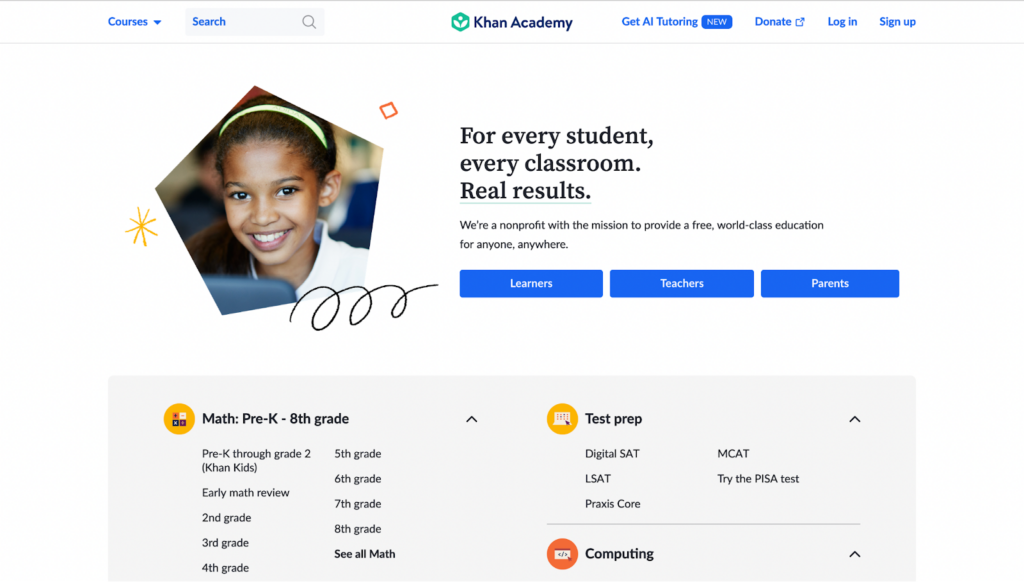
Founder Sal Khan created Khan Academy with the goal of democratizing education and making quality learning resources accessible to students of all backgrounds. The site’s best known for teaching mathematics and the sciences, but they offer instruction on everything from computer science to economics.
Khan Academy also offers tools for teachers, as well as parents supporting their child’s education. You can assign lessons to learners, track learner progress, and tailor content to meet each student’s needs on the built-in learning dashboard.
If you’re looking for free and reliable learning content for students of all ages – from primary school through to college – then Khan Academy could be the top Udemy alternative for you.
All Khan Academy content is created in-house, funded by a wealth of sponsors including the Bank of America, CollegeBoard, and the Bill and Melinda Gates Foundation. That means that it’s not open to everyday course creators looking to earn money from selling digital products online. But it’s a top choice for students, parents, and teachers alike
Pros:
- Free to all: Khan Academy’s courses are free for all students and teachers. If you’re a public school teacher who needs well-created learning content at zero cost, look no further.
- Tailored to students: This Udemy alternative is designed for students so the content is extremely specialized and arranged according to subject and grade level.
- Create custom learning paths: Although you can’t create entirely custom learning tracks – or upload courses you create – you can cherry-pick lectures for your students and group related concepts together.
Cons:
- Not open to course creators: Khan Academy handles all its content in-house so it’s not open to individual Creator Educators and organizations.
- No earning potential: You can’t earn money from the Khan Academy platform – so it’s not an option if you’re looking for an Udemy alternative that works for your business.
- Limited range of topics: Khan Academy caters specifically to the American education system and the needs of American students. This means their content on tech, the arts, and language learning is more limited than other platforms.
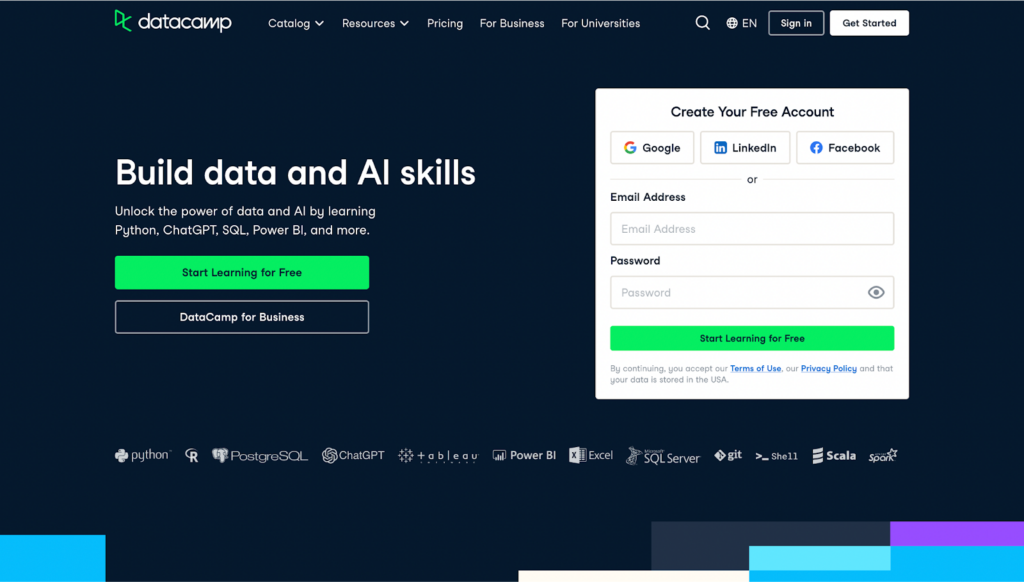
Expert-level coders and data whizzes, listen up – this is the Udemy alternative for you! Founded in 2013, DataCamp offers 400+ data courses taught by subject matter experts, geared towards learners interested in careers in data science and analytics.
DataCamp is the best-known online learning platform for prospective data scientists offering highly interactive courses for its audience of over 9 million learners.
DataCamp recruits educators who are both passionate about teaching and about analytics. To publish a course on DataCamp, you have to apply to the platform – but be warned, the process isn’t quick.
Potential instructors start by submitting an application where they’re asked to choose a course they’d feel comfortable teaching from DataCamp’s wishlist. Then you need to submit a potential course outline via a Google form. If all goes well, you’ll be contacted to do a brief five-minute presentation breaking down one of the key concepts in your course outline. If your application is approved, you can then get down to developing your first course – with support from DataCamp’s in-house team of experts.
How do instructors get paid? DataCamp subscribers pay a monthly subscription to access their library of courses and DataCamp partners with instructors who are paid through a revenue-sharing program that’s based on course completions.
Every time a DataCamp subscriber completes your course, you’ll earn a royalty cheque. And with their dedicated audience base, that can quickly add up. DataCamp instructors report earning approximately 4,250 per month in passive income with the top five instructors on the platform earning over $53,000 per year.
Data science is still a niche subject area, but it’s growing fast. If you’ve got the analytics chops to teach it, DataCamp may be the right platform for you.
Pros:
- Extensive dedicated community: With over 16.9 million registered learners, DataCamp has one of the biggest user bases in the data science space. Instructors who apply successfully will have access to an extensive and engaged data science community.
- Royalty-based payments: Unlike Udemy, DataCamp creators are paid based on course completions. Every time a subscriber makes it to the end of your course, you’ll earn a royalty. Top instructors can earn over six figures from their content.
- Full ownership over content: Creators retain full ownership of any content they create and publish on the DataCamp platform.
Cons:
- Narrow subject area: DataCamp only caters to data and computer scientists, so if you’re in a different field, this isn’t the platform for you. Instead, opt for a more general online learning platform like Thinkific.
- Need to be accepted to the platform: Without serious industry credentials and teaching skills to match, even seasoned data scientists may have trouble getting accepted as DataCamp instructors.
- Quarterly payments: Royalties for DataCamp’s revenue share system are paid out quarterly. This means that you won’t have a constant flow of cash.
Still need help deciding? Check out our tips on how to find the best Udemy alternative for you.
Free Buyer’s Guide: The Best Online Course Platforms
Get a run-down of the 9 of the best Online Course Platforms, 6 must-know features, and what their customers say about them with this guide.
How to choose the best Udemy alternative for you
To help you find the best Udemy alternative for your needs, you first need to decide if you’re looking for a learning marketplace or a self-hosted online learning platform. Each has their own benefits and downsides – so it’s worth thinking carefully at this stage.
Here’s a quick overview of the two types of course platforms and the key differences you need to know:
Learning marketplaces
Learning marketplaces sell courses wholesale and are essentially a third-party that connects educators with learners. If you’re selling courses through a learning marketplace, you’ll create your course and upload it to the marketplace, where they’ll then brand it and promote it for you – in exchange for a cut of the profits.
Course marketplaces like Udemy have massive built-in audiences who are searching for and buying courses. That means a large base of potential customers for your content. But instructors on Udemy only receive 37% of the revenue from sales through Udemy’s marketplace – so the earning potential is limited.
This type of learning platform has been around for longer than self-hosted online learning platforms and they tend to be more common. Coursera, Skillshare, and Udemy are all learning marketplaces.
Online learning platforms
Online learning platforms offer course creators a different model. They give you the tools to create your own courses, build dedicated websites, grow a branded learning community, and more.
With this model you pay a flat monthly fee to use the platform instead of losing a percentage of your course sales or relying on royalties. Whatever you earn goes straight into your bank account, which means that if your course becomes popular, your earnings go up – and your business is extra easy to scale.
This model gives creators more control and more flexibility. Thinkific plans start at $0/month, so you can try the platform for free and launch your first course right away with no obligation to pay more.
Choosing the right platform
The type of learning platform that’s right for you will depend on your unique needs – including the types of products you’re creating, your experience in your industry, and what you’re looking to achieve with your content.
The truth is, you don’t have to pick between using marketplaces and online learning platforms – in fact, many creators use both.
If you opt to use both types of platform in your course marketing strategy, take advantage of the bigger built-in audience you’ll find on online marketplaces like Skillshare to generate awareness for your brand and bag new leads. Then once you’ve hooked people with an entry-level course, you can promote your courses on a self-hosted online learning platform where you can earn more, grow your community and dive deeper into your area of expertise.
Ready to find your top online learning platform?
While Udemy is a popular choice for many creators, it’s not the only online learning platform out there. In fact, there are a wide range of Udemy alternatives that could be a better fit for you and your needs.
At Thinkific, we’re all about breaking down the barriers to entering the course creation business. We make it easy to earn money from your experience by selling self-guided online courses, membership sites, and a whole range of digital products. Our easy-to-use platform is built for Creator Educators to make designing engaging, custom learning experiences easy. Your first course is just the start…
Launch your online learning product for free Start selling your online course and community on a 100% free plan that actually remains free. 
This blog was originally published in February 2021. It has since been updated in February 2024 to become even more useful!








